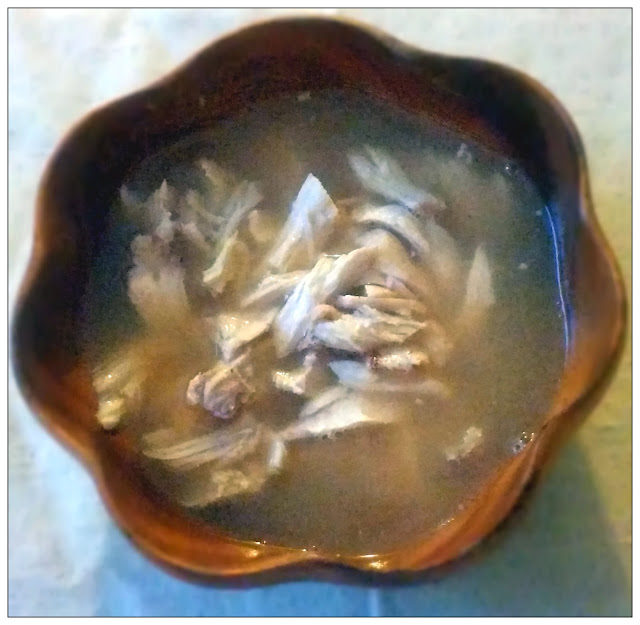 |
| Auter brawn en peuerade |
This recipe, located at Two fifteenth-century cookery-books. Harleian ms. 279 (ab. 1430), & Harl. ms. 4016 (ab. 1450), with extracts from Ashmole ms. 1429, Laud ms. 553, & Douce ms. 55" Thomas Austin, appears to be one of the more popular versions of Brawn en Peuerade. A search on the internet revealed many and varied interpretations. Unlike the Brawn en Peuerade I made last week, this version is a broth based version, flavored with wine. It is much more "savory" in flavor.
.xxxij. Auter brawn en peuerade. — Take myghty brothe of Beef or of Capouu, an ]-'enne take clene Freysshe Brawn, an sethe it, but not y-now; An jif it be Freysshe Brawn, roste it, but not I-now, an ]7an leche it in pecys, an caste it to fe brothe. An Jeanne take hoole Oynonys, & pylle hem, an )'anne take Yynegre J'er-to, and Canelle, and sette it on fe fyre, an draw yt foTW a straynoure, and caste J'er-to ; j^en take Clowys, Maces, an powder Pepyr, an caste J>er-to, and a lytil Saunderys, an sette it on j>e fyre, an let boyle tylle ]>e Oynonys an ]?e Brawn ben euyne sothyn, an nowt to moche ; Jian take lykoure y-mad of Bred an Yinegre an Wyne, an sesyn it vp, an caste J'er-to Saffroun to make J^e coloure bryth, an Salt, an serue it forth.
For information on similar recipes, visit Medieval Cookery at the link below.
xxxij - Auter brawn en peuerade. Take myghty brothe of Beef or of Capoun, an thenne take clene Freysshe Brawn, an sethe it, but not y-now; An 3if it be Freysshe Brawn, roste it, but not I-now, an than leche it in pecys, an caste it to the brothe. An thanne take hoole Oynonys, and pylle hem, an thanne take Vynegre ther-to, andCanelle, and sette it on the fyre, an draw yt thorw a straynoure, and caste ther-to; then take Clowys, Maces, an powder Pepyr, an caste ther-to, and a lytilSaunderys, an sette it on the fyre, an let boyle tylle the Oynonys an the Brawn ben euyne sothyn, an nowt to moche; than take lykoure y-mad of Bred an Vinegre anWyne, an sesyn it vp, an caste ther-to Saffroun to make the coloure bryth, an Salt, an serue it forth.
32. Another brawn in peverade - Take mighty broth of beef or of capon, and then take clean fresh brawn (pork or boar), and boil it, but not enough, and if it be fresh brawn, roast it, but not enough, and then slice it in pieces, and cast it to the broth. And then take whole onions, and peel them, and then take vinegar there-to, and cinnamon, and set it on the fire, and draw it through a strainer, and caste there-to; then take cloves, mace, and powder pepper, and cast there-to, and a little sandalwood, and set it on the fire, and let boil till the onions and brawn are evenly cooked, and not too much; then take broth made of bread and vinegar and wine, and season it up, and cast there-to saffron to make the colored broth, and salt, and serve it forth.
Interpreted Recipe Serves 1 as main, 2 as a side
1 c. broth (beef, chicken or a 50/50 mix)
1/4 pound roasted pork, thinly sliced
1/3 c. pearl onions1 cinnamon stick
2 cloves
1/8 tsp. mace
1/4 tsp. pepper
1 tsp. sandalwood (saunders)
2 tsp. red wine vinegar
2 tbsp. red wine
2 tbsp. bread crumbs
pinch of saffron
Heat the broth with the saffron and sandalwood until it develops a ruddy hue. Add the pork, onions, cinnamon, cloves, mace and pepper and bring it to a broil until the pork becomes tender and the onions are cooked through. Meanwhile, soak the bread crumbs in the wine and the vinegar until they are softened. When the pork is tender and the bread crumbs are softened, fish out the cinnamon and cloves from the broth and then add the bread to the mixture, stirring until the broth has thickened to your desire.
This is a wonderful soup and has gone onto my "must serve at a future event" list, whether that is a luncheon or a feast. The sliced pork is a little difficult to eat the way I sliced it, so in the future I will be sure to cut it into bite sized cubes instead. I might also consider increasing the amount of wine. The pepper added a very nice "bite" to the dish.










